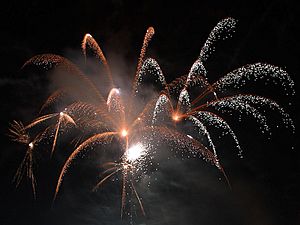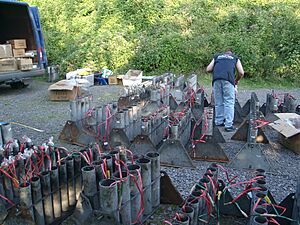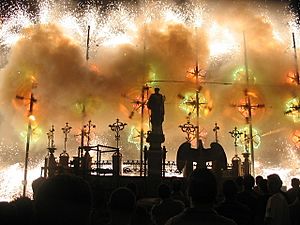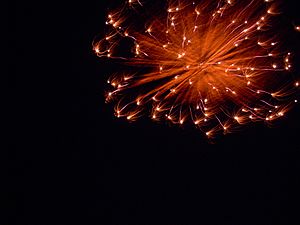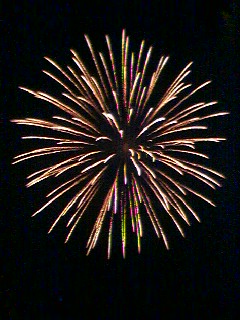Firework facts for kids
A firework is a special device that uses small explosions to create amazing shows. People mostly use fireworks for fun and entertainment. The most common way to see fireworks is during a fireworks display, which is a big show with many fireworks going off.
Fireworks are designed to do four main things: they make loud noises, bright lights, smoke, and sometimes even release floating materials like confetti. They can also burn with colorful flames and sparks. Fireworks shows are popular all over the world. They are a big part of many cultural and religious celebrations and festivals. For example, people often use fireworks on Independence Day, New Year's Eve, and Guy Fawkes Night.
Some fireworks stay on the ground, while others shoot high into the air. Because they can explode and cause fires or burns, most countries have rules. These rules usually mean that only trained experts can use large display fireworks. Smaller, less powerful fireworks can be bought by regular people. However, even these can be dangerous and cause injuries every year.
Contents
- The Amazing History of Fireworks
- Cool Types of Firework Effects
- Cake Fireworks
- Crossette Fireworks
- Chrysanthemum Fireworks
- Dahlia Fireworks
- Diadem Fireworks
- Fish Fireworks
- Horsetail Fireworks
- Kamuro Fireworks
- Mine Fireworks
- Multi-break Shells
- Noise-related Effects
- Palm Fireworks
- Peony Fireworks
- Ring Fireworks
- Roman Candle Fireworks
- Salute Fireworks
- Spider Fireworks
- Time Rain Fireworks
- Willow Fireworks
- Images for kids
- See also
The Amazing History of Fireworks
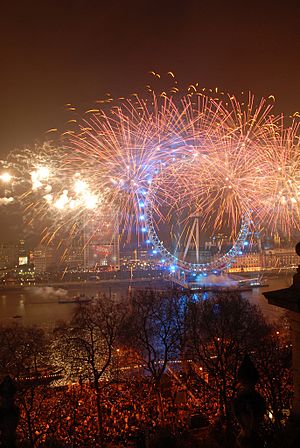
Fireworks have a very long history, going all the way back to the 7th century. They first started in China. The Chinese people were very clever and created many different kinds of fireworks. They made fireworks with all sorts of effects and colors. Making fireworks became a special skill, and people who were good at it were highly respected. These experts knew many complex ways to set up amazing fireworks shows.
During the Song Dynasty in China (from 960 to 1279), many ordinary people could buy different kinds of fireworks from market sellers. Big fireworks displays were also very common. For example, in 1110, a huge fireworks show was held during a military event to entertain Emperor Huizong. Later, in 1264, a record tells us that a rocket-powered firework went off near the Empress Dowager Gong Sheng during a party. This shows how fireworks were becoming more advanced.
Rocket technology was also used in wars. Around 1240, people in Arab countries learned about gunpowder and how to use it from China. A Syrian person named Hasan al-Rammah wrote about rockets and fireworks. He used words that suggested he learned from Chinese sources. He even called fireworks "Chinese flowers."
More recently, the New Year's Eve celebrations in 2014 in Dubai set a world record. They had the biggest fireworks display ever seen!
Cool Types of Firework Effects
Cake Fireworks
A cake firework is a group of many tubes connected by a fuse. These tubes shoot a series of effects into the sky. The tubes can be different sizes, and one cake can have over 1,000 shots! Cake fireworks often have creative names like "Bermuda Triangle" because they create so many different effects.
Crossette Fireworks
A crossette firework shoots out several large stars. These stars travel a short distance and then break into smaller stars. This creates a cool crisscrossing, grid-like pattern in the sky. Originally, they were silver or gold, but now you can see colored crossettes in red, green, or white.
Chrysanthemum Fireworks
This firework creates a round burst of colored stars. It's similar to a peony firework, but the stars in a chrysanthemum leave a visible trail of sparks as they fly.
Dahlia Fireworks
Dahlia fireworks are like peony shells but have fewer, larger stars. These stars travel a longer distance from where the shell bursts before they fade away. Some dahlia shells are shaped like cylinders instead of spheres to hold these bigger stars.
Diadem Fireworks
A diadem firework is a type of chrysanthemum or peony. It has a cluster of stars in the middle that don't move, often in a different color or with a special effect.
Fish Fireworks
These fireworks create small shapes that move quickly away from the main burst. They look just like fish swimming away in the sky!
Horsetail Fireworks
Named for its shape, this firework looks like a horse's tail. It has heavy, long-burning stars with tails that only travel a short distance from the burst. Then, they fall slowly to the ground, creating a "waterfall" effect.
Kamuro Fireworks
"Kamuro" is a Japanese word meaning "Boys Haircut," which is what this firework looks like when it fully explodes. It creates a thick burst of shiny silver or gold stars. These stars leave a heavy, glittering trail and look very bright in the night sky.
Mine Fireworks
A mine firework is a ground firework that shoots stars or other decorations into the sky. It's launched from a tube, similar to a shell. Mines can send up small bangs, snake-like effects, tiny shells, or just stars. They are usually between 3 and 5 inches wide, but sometimes much larger ones appear.
Multi-break Shells
These are large fireworks shells that contain several smaller shells inside. When the main shell bursts, it scatters the smaller shells across the sky. Then, these smaller shells explode too! This effect is sometimes called a "bouquet shell." If it contains many small shells of the same type, it's called "Thousands." Very large bouquet shells are often used in Japan.
- Bangs and Report: The "bang" is the most common sound in fireworks. It sounds like a gunshot and is technically called a "report."
- Crackle: This firework makes a crackling sound, like tiny sparks popping.
- Hummers: These are tiny tube fireworks that spin very fast when shot into the air. As they spin, they shred their outer layer, making a whizzing and humming sound.
- Whistle: This creates a high-pitched, often very loud screaming or screeching sound. It happens because the fuel burns on and off very quickly, making the air vibrate hundreds of times per second.
Palm Fireworks

A palm firework has a few large, special stars that burst to create big arms or tendrils. This makes it look like a palm tree. Good palm shells also have a thick tail that rises as the shell goes up, looking like the tree trunk. Sometimes, a small burst of color inside the palm burst can even look like coconuts!
Peony Fireworks
This is the most common type of firework shell. It creates a round burst of colored stars that burn without leaving a tail of sparks.
Ring Fireworks
A ring firework has stars arranged in a special way to create a perfect ring shape in the sky. Some variations can even make shapes like smiley faces, hearts, or clovers!
Roman Candle Fireworks
A Roman candle is a long tube that shoots several large stars one after another at regular times. These are often arranged in fan shapes or crisscrossing patterns, closer to the audience. Some bigger Roman candles even shoot small shells instead of just stars.
Salute Fireworks
A salute firework is made to create a very loud bang rather than a visual effect. They usually contain a special powder that makes a quick flash followed by a very loud noise. Sometimes, a metal called titanium is added to create bright sparks around the flash. Salutes are often used a lot during the grand finales of fireworks shows to make a lot of noise and brightness.
Spider Fireworks
A spider firework has fast-burning stars with tails or charcoal. These stars burst very hard and travel in a straight, flat line before falling slightly and burning out. This looks like many lines spreading out in the sky, just like the legs of a spider.
Time Rain Fireworks
This effect is created by large, slow-burning stars inside a shell. These stars leave a trail of big, glittering sparks behind them and make a sizzling sound. The "time" part means that these stars burn slowly over time, unlike other "rain" effects where a lot of glitter is released all at once.
Willow Fireworks
Similar to a chrysanthemum, a willow firework has long-burning silver or gold stars. These stars create a soft, dome-shaped effect that looks like the weeping branches of a willow tree.
Images for kids
-
An illustration of a fireworks display from a 1628–1643 edition of the Ming Dynasty novel Jin Ping Mei
-
An etching of the Royal Fireworks display on the Thames, London, England, in 1749
-
A firework display by the British illustrator Ebenezer Landells, possibly the display given by Napoleon III on Queen Victoria's 1855 visit to Paris
-
Copper compounds glow green or blue-green in a flame
-
A firework rocket preparing its launch on the American Independence Day
-
Haze caused by smoke from fireworks, combined with smoke from wildfires few miles away from where the photo was taken
See also
 In Spanish: Fuegos artificiales para niños
In Spanish: Fuegos artificiales para niños


